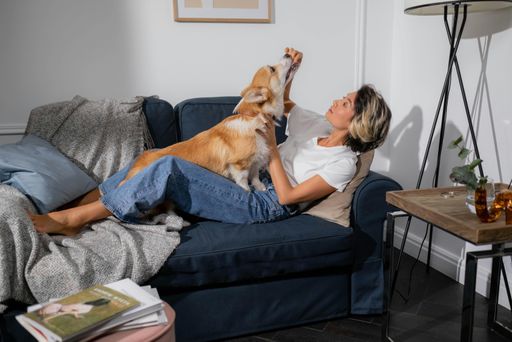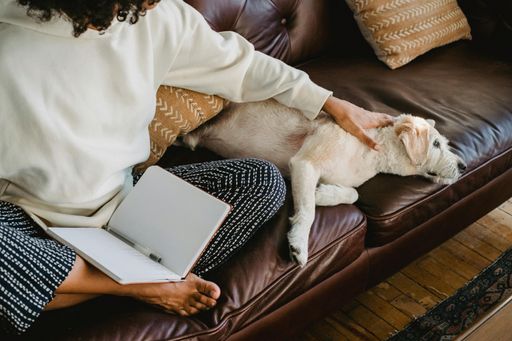Dogs become instant members of the family from the moment we welcome them into our homes. Their endless loyalty and love make them so endearing to dog lovers. No surprise then that within recent pandemic times adoptions globally surged in Spring 2020, and the UK alone has seen 3.2 million households adopt dogs since the pandemic began.
However, owning a dog does come with risks and many pet owners are vulnerable to crime, or worse, their dogs are. Many are stolen for breeding purposes as the price and demand for puppies has gone through the roof in recent years.
There are many heartbreaking stories of dogs being stolen away from owners while on walks, at home or from cars. We’re going to take a look at how you can keep you and your dog safe from crime.
Tagging your dog in social media pictures
Let’s start with one of the toughest things to restrict, doggy social media. It’s so easy to take a few snaps of our dogs looking cute, or silly, and share them online. Sharing images of our lives with friends and family is a given but sharing images of your dog might spell trouble.
Things like tagging your location when sharing images of your dog could lead thieves to your door or your walking routes. If they know where you are going to be they might show up and attempt to take your dog from you.
How to discourage dog snatchers on walks
We touched on how social media makes your dog a target for thieves but that’s not the only way they steal people’s beloved pets. Our dogs need walking but the simple act of doing that can make them a target, especially if they are a pedigree or fashionable breed.
Thankfully, there are measures we can take to make it much harder for thieves to steal our dogs. Theftproof dog collars and leads stop your pooch from being snatched right out of your hands. They are typically made using cut-proof materials, stopping thieves from untethering your animal with scissors or knives.
Whilst contact details should be present on a dog collar or tag, there are surprising do’s and don’ts as to exactly what information we should safely include. Many of us would automatically add our dog’s name.This may feel like the right thing to do but also provides thieves with a way to lure the dog away, especially if they have a pocket full of treats for further encouragement.
Changing our behaviour
Mixing up walking routes makes it less predictable for thieves observing your movements to know where your pooch is going to be at a certain time. This is also highly beneficial to your dog as a varied walking route stops it from becoming overfamiliar.
“Changing the walk route allows the dog to encounter novel scents and new scenery,” say experts at PetMD. “Dogs love routines, but to get the most out of your walks, don’t become robotic about them.”
Treat strangers with caution if they start asking questions about your dog. This is often how dogs are snatched so look out for the stranger bending down to stroke your dog or any vehicles slowing down around you. If possible, walk in pairs as the extra numbers act as a deterrent for dog snatchers; dealing with just one person is easier than multiple.
While it might seem excessive, consider carrying an alarm device in case your dog is stolen. A loud alarm draws unwanted attention to the dog snatcher and this might be enough for them to let your pet go as they run away. Think of it a little like a car alarm for your dog, the more attention on the thief the less likely they are to continue.
Train a strong recall - knowing that your dog will come bounding back to you is not only great peace of mind but it can save them from being stolen.
Stopping pet crime at home
Our homes are meant to be our sanctuaries but, unfortunately, they are also becoming a dog thief hunting ground. Letting your four-legged friend loose in the garden should be safe but always make sure you can see what they are doing.
Don’t leave your dog outside unsupervised, especially in the front garden where anyone can walk past and grab them. We suggest making your garden completely enclosed with a lock on the gates. You could even fit a bell to the gate so you are alerted to anyone coming in or out of your garden.
If you are leaving your dog home alone for a while, consider whether a friend or neighbour can come over in your absence. A persistently barking dog could alert a thief that they are home alone. Consider reducing separation anxiety by playing media when you’re not home.
Pet monitoring tech
Technology often makes our lives easier and it’s now possible to check in on your dog remotely. Pet supervising apps, like the Ring camera, allow you to watch what your dog is doing while you are in the office or at the doctor. They allow you to see whether your dog is relaxing at home or if they are suffering from separation anxiety.
While useful for owning a pet, these monitoring apps also leave us vulnerable to outside attacks. Cybersecurity experts, Redscan, suggest to “protect personal devices with numeric or alphanumeric passwords (ideally not a pattern as these can be easily guessed!), use antivirus software and configure automatic software updates”.
Outdated apps have cybersecurity vulnerabilities and most updates for apps are done to increase protection from threats. Giving a cybercriminal easy access to data can lead to money being transferred from your account, counterfeit credit cards being created and financial information being sold on the dark web. Keep them at bay by updating your apps as frequently as possible.
Rethink those internet passwords
Another problem with tagging your dog on social media channels is advertising your password to cybercriminals. “One in six people use their pet’s name as a password”, says Amer Owaida of We Live Security.
Letting the whole world know your pet’s name is potentially an open invitation for cybercriminals to try and hack into your logins. Being an animal lover can make your passwords vulnerable so ensure that your dog’s name is nowhere near your online profiles.
Microchips and GPS trackers
If the worst does happen and your dog is stolen from you, the last line of defence is an updated microchip and GPS tracker. Of course, the first thing you should do is call the police to try and get them to retrieve your dog for you. Insist that they record it as a theft rather than a lost animal so you are given a crime number.
The second call you should make is to the microchip database. This ensures that if someone tries to register your dog, the database will be alerted to it and your dog can be found. “Dogs with microchips were 2.5 times more likely to be returned home than those without”, according to a study by Ohio State University College of Veterinary Medicine.
Using a collar with a GPS tracker fitted is also a great way to track your dog’s movements in the aftermath of the theft. This GPS tracker could lead investigators right to the door of the person who stole your dog. In the instance that your dog has managed to flee and is roaming around alone, the tracker will also assist with tracing too.



















